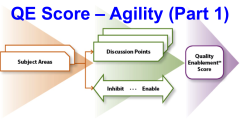… Can be Measured (Agility Dimension) – Part 1 of 2

“The problem is never how to get new, innovative thoughts into your mind, but how to get old ones out. “
Dee Hock, Founder of Visa
Today, we’ll continue our discussion with the details of the Subject Areas and Discussion Points in the Agility Dimension to calculate this part of the overall QE Score. For a review of the Agility Dimension, click here.)
As we did with the People Dimension discussion, we’ll split this one into two parts, this week and next. There are 8 Subject Areas in the Agility Dimension – we’ll cover 4 each week.
As we’ve done previously, I’ve included the weight (e.g. [3]) and guidelines for scores of 1, 4, and 7. Those that are purely inhibiting are tagged with “(inhibiting)” and only have guidelines for 1 & 4; likewise, those that are purely enabling are tagged with “(enabling)” and only have guidelines for 4 & 7.
QE Score Assessment – Agility Dimension – Part 1
Communication

- How effectively do you think “real” information (not gossip) flows through the organization? [3]
1 – Real information flows very poorly, at least to me and my team
4 – Not badly – we hear the important information
7 – Very well – our team members have a good idea what is going on across the organization
- How successfully is the information used? [3]
1 – What we hear isn’t used by us at all
4 – The information does drive some of our team decisions
7 – We actively use the information we receive to adjust our projects to deliver maximum customer value
- How are business decisions communicated to affected stakeholders? [3]
1 – We rarely know about business decisions
4 – Those who management believe need the information get it
7 – There are multiple channels of communication for business decisions – meetings, emails, on-line portals, etc. – that reach all of us
Stakeholder Involvement

- What role do external stakeholders have in project decisions? (enabling) [3]
4 – None
7 – We actively seek external stakeholder participation in project decisions that impact them
- What role do internal stakeholders have in project decisions? (enabling) [4]
4 – None
7 – We actively seek internal stakeholder participation in project decisions that impact them
- What role do external stakeholders play in projects? (enabling) [3]
4 – None
7 – External stakeholders play active roles to ensure we are meeting their needs
- What role do internal stakeholders play in projects? (enabling) [4]
4 – None
7 – Internal stakeholders play active roles to ensure we are meeting their needs
Failure Tolerance

- How does the team react when something under their control fails? [3]
1 – We blame the individual responsible for the failure
4 – We take it in stride and press on
7 – We treat the failure as a learning opportunity and determine what we need to improve / change
- How do the immediate managers respond when the team fails? [4]
1 – The failure ends up as a “ding” against the responsible team member
4 – They understand that failures are part of the process and don’t penalize the team / individuals
7 – They provide active support to the learning process and provide whatever help we need to make the necessary changes
- How do senior managers respond to failure? [5]
1 – The failure ends up as a “ding” against the responsible team member
4 – They understand that failures are part of the process and don’t penalize the team / individuals
7 – They provide active support to the learning process and provide whatever help we need to make the necessary changes
- How do external stakeholders respond to failures? [3]
1 – They get frustrated … they don’t understand why we fail
4 – They understand that failures are part of the process and don’t penalize the team / individuals
7 – They provide active support to the learning process and provide whatever help we need to make the necessary changes
- How do internal stakeholders respond to failures? [4]
1 – They get frustrated … they don’t understand why we fail
4 – They understand that failures are part of the process and don’t penalize the team / individuals
7 – They provide active support to the learning process and provide whatever help we need to make the necessary changes
Organizational Learning

- How do team failures become truly lessons learned for the organization? (enabling) [4]
4 – The failures stay within the individual teams
7 – We have an active program to share both the failures and suggested improvements, and solicit input from other teams
- Tell me about the process that teams use for their iteration retrospectives [4]
1 – We don’t have retrospectives
4 – We hold regular retrospectives, but it’s more to “check a box” than actually make improvements
7 – We have an open discussion to see what we can learn – we discuss what worked well, what didn’t, the changes we want to make and any other questions we have
- What is done to address issues raised during the retrospectives? (enabling) [4]
4 – Nothing
7 – We track all issues through to resolution
- How frequently are team retrospectives held? [4]
1 – Never
4 – About half the time
7 – After every iteration
What’s Next
Next week, we’ll complete the discussion of the Subject Areas we use to determine the Agility Dimension component of the QE Score.
Until Then …
“It is not the strongest of the species that survive, nor the most intelligent, but the one most responsive to change.”
Charles Darwin

What are your thoughts? Please share your comments in the block below.